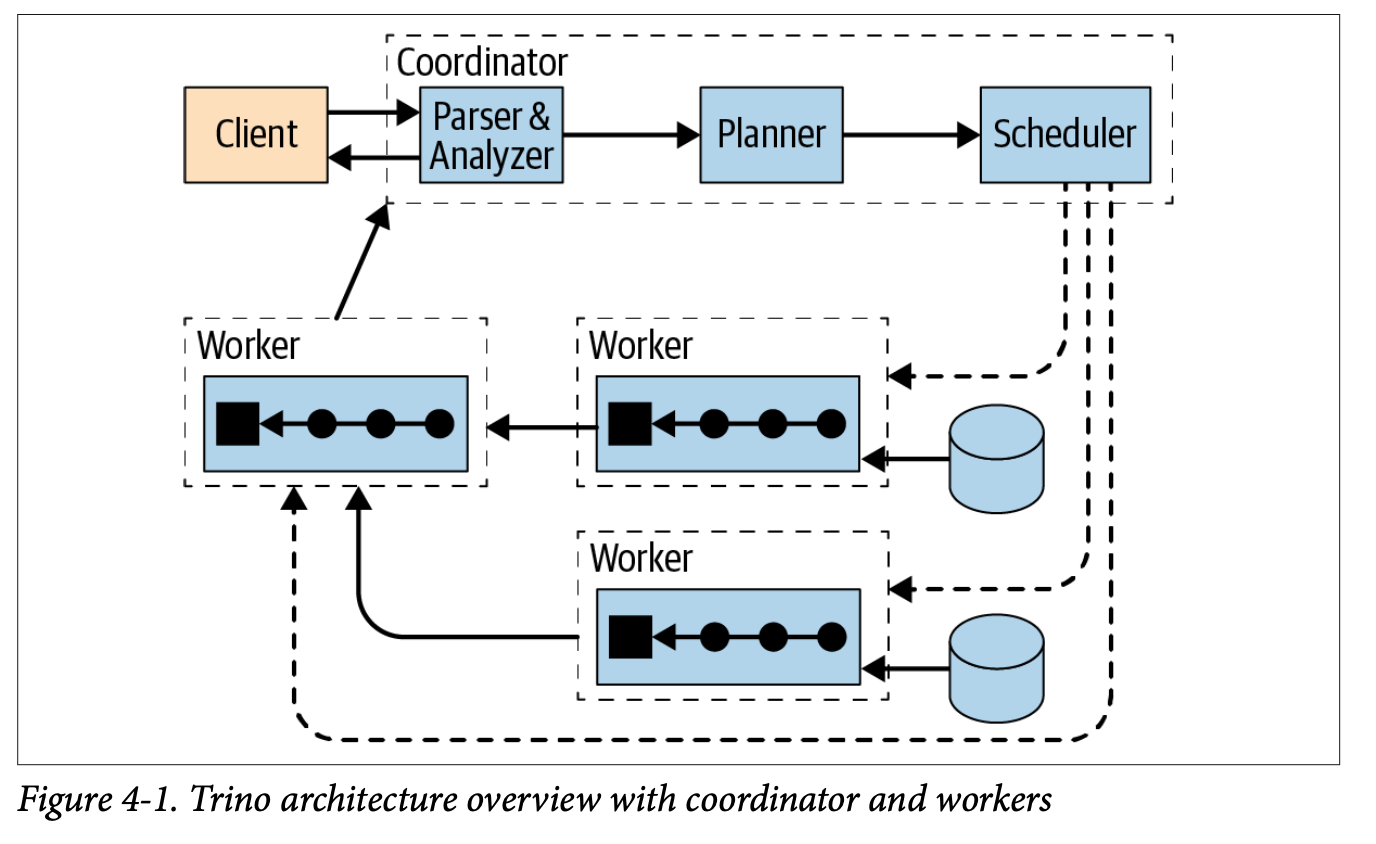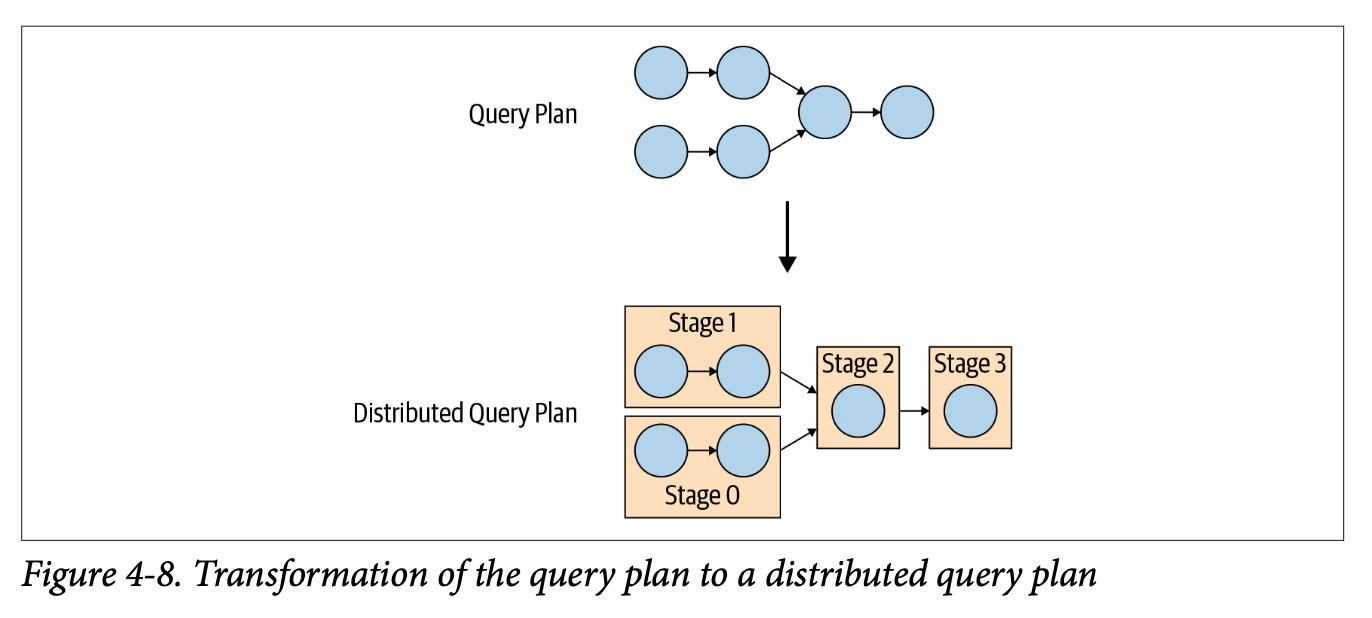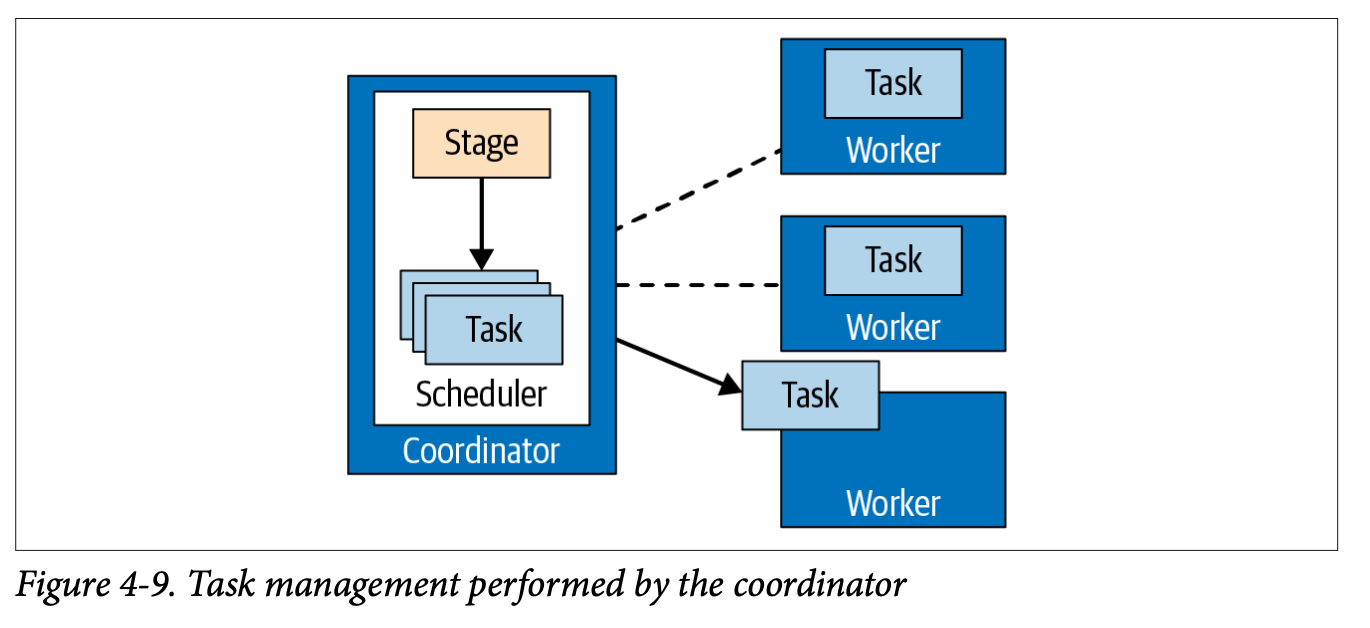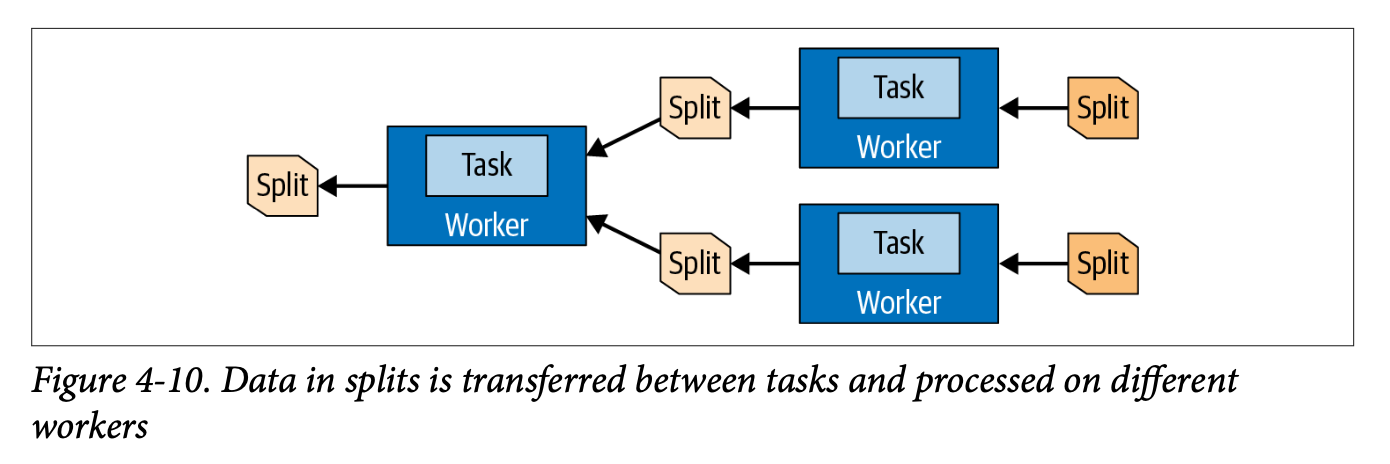How It Works?¶
 Trino: The Definitive Guide
Trino: The Definitive Guide
Architecture Components¶
Coordinator¶
- The Trino coordinator is the server that is responsible for parsing statements, planning queries, and managing Trino worker nodes. It is also the node to which a client connects to submit statements for execution. The coordinator keeps track of the activity on each worker and coordinates the execution of a query. The coordinator creates a logical model of a query involving a series of stages, which is then translated into a series of connected tasks running on a cluster of Trino workers. Coordinators communicate with workers and clients using a REST API. The coordinator is responsible for fetching results from the workers and returning the final results to the client.
Worker¶
- A Trino worker is a server that is responsible for executing tasks and processing data. Worker nodes fetch data from connectors and exchange intermediate data with each other. When a Trino worker process starts up, it advertises itself to the discovery server in the coordinator, which makes it available to the Trino coordinator for task execution.
Cluster¶
- A Trino cluster consists of several Trino nodes - one coordinator and zero or more workers. The coordinator and the workers access the connected data sources. This access is configured in catalogs.
Clients¶
- Clients allow you to connect to Trino, submit SQL queries, and receive the results. Clients can access all configured data sources using catalogs.
Core Concepts¶
Data Sources¶
Trino serves as a distributed query engine capable of accessing a wide variety of data sources. These encompass data lakes, lakehouses, various relational database management systems, key-value stores, and numerous other storage systems.
To enable data access, you must configure a catalog with the appropriate Trino connector tailored to your specific data source.
Connectors¶
Connectors serve as adapters that enable Trino to interface with various data sources, including data lakes built on Hadoop/Hive or Apache Iceberg, as well as relational databases like PostgreSQL.
Think of connectors similarly to database drivers—they are concrete implementations of Trino's service provider interface (SPI) that provide a standardized way for Trino to communicate with external resources through a consistent API.
Catalogs¶
A catalog in Trino represents a configuration that enables access to a specific data source through a designated connector. Each catalog is defined by a collection of properties stored in configuration files within the Trino configuration directory.
The fundamental requirement for any catalog is the connector.name property, which specifies which connector implementation to use for that particular data source. Beyond the connector specification, catalogs also include additional configuration details such as authentication credentials, connection URLs, and other source-specific parameters.
Multiple catalogs can be configured simultaneously, allowing Trino to connect to various data sources. These catalogs may utilize different connector types or even multiple instances of the same connector type to access distinct data sources.
Within each catalog's scope, you'll find a hierarchical structure consisting of schemas. These schemas serve as organizational containers for database objects including tables, views, and materialized views, providing a logical grouping mechanism for the data accessible through that catalog.
Behind the Scenes¶
Query Execution Model¶
A user starts by sending an SQL statement from a client tool, such as DBeaver, Superset, or a custom application, to the Trino cluster. The statement is a plain-text command like SELECT region, COUNT(*) FROM sales GROUP BY region;. It first arrives at the coordinator, which is the brain of the Trino system.
The coordinator begins by parsing this statement, checking for syntax and semantic correctness. Once validated, the statement is transformed into a query. The query is more than just text. It's a fully-formed plan that defines how the cluster will execute the user's command.
The query is broken down into a hierarchy of stages, forming a distributed execution plan. These stages form a tree-like structure, where each stage represents a logical step of the query, such as scanning data, performing aggregation, or returning final results.
 Trino: The Definitive Guide
Trino: The Definitive Guide
 Trino: The Definitive Guide
Trino: The Definitive Guide
Although stages define what needs to be done, they don't perform the actual computation. Instead, each stage is implemented through multiple tasks. These tasks are distributed across worker nodes in the cluster. Each task is responsible for executing a portion of its parent stage, and together, the tasks accomplish the overall goal of that stage.
 Trino: The Definitive Guide
Trino: The Definitive Guide
Each task works on specific chunks of data called splits. A split is a subset of the overall dataset. For example, a single Parquet file or a segment of rows. The coordinator asks the storage connector (such as the Hive connector) for a list of available splits for a given table and then assigns those splits to the tasks running on various workers.
 Trino: The Definitive Guide
Trino: The Definitive Guide
Within each task, the execution is further broken down into one or more drivers. A driver is essentially a data pipeline that runs in a single thread. Each driver consists of a series of operators. These operators perform concrete operations like scanning a table, filtering rows, applying functions, or aggregating values. You can think of a driver as a physical pipeline built from operator components.
For example, a driver in this case might include a table scan operator that reads rows from the sales table, followed by a filter operator that removes NULL regions, and an aggregation operator that performs the GROUP BY region logic.
 Trino: The Definitive Guide
Trino: The Definitive Guide
As data flows upward from lower stages to higher ones, exchanges come into play. These are the network mechanisms that transfer data between nodes. When one stage finishes processing, it places its output into buffers. The next stage pulls data from these buffers using an exchange client, ensuring the distributed stages stay connected even across physical nodes.
Once the root stage finishes aggregating the results from its child stages, the final output is assembled by the coordinator and returned to the client. What the user sees is a neatly formatted result set with regions and counts, but under the hood, that simple output is the product of a highly parallel and distributed pipeline involving statements, queries, stages, tasks, splits, drivers, operators, and exchanges.
Client Protocol¶
sequenceDiagram
participant Client
participant Coordinator
Client->>Coordinator: Submit SQL query
Coordinator->>Coordinator: Start processing query
Coordinator-->>Client: Return initial result + nextUri
loop Fetching result set
Client->>Coordinator: Request nextUri
Coordinator-->>Client: Return data + nextUri (or FINISHED)
end
alt Client stops requesting
Coordinator-->>Client: Return USER_CANCELED
endSee Client Protocol | Trino for more.